Two-Phase Production Performance of Multistage Fractured Horizontal Wells in Shale Gas Reservoir
Abstract
1. Introduction
2. Materials and Methods
2.1. Physical Model
- Central wellbore placement: The wellbore is located centrally in the reservoir, with its length denoted by L. This assumption simplifies the geometric representation of the wellbore and its interaction with the reservoir.
- Fracture asymmetry: Post-fracturing, N fractures are introduced, which exhibit varying asymmetry levels relative to the wellbore. This assumption allows the model to account for non-uniform fracture distributions, although the analysis in this study primarily uses uniform fracture spacing and symmetry for demonstration purposes.
- Flow mechanism: The fluid first travels from the reservoir matrix into the fractures, and then into the wellbore. This assumption reflects the dual-porosity nature of shale gas reservoirs but may not fully capture more complex flow mechanisms, such as the direct matrix-to-wellbore flow in certain scenarios.
- Steady-state flow: The model assumes steady-state flow conditions, which may not fully represent the transient behavior of shale gas reservoirs during early production stages or under rapidly changing reservoir conditions.
- Static fracture network: The fractures are assumed to remain static during production, ignoring potential dynamic changes such as fracture closure or propagation due to stress redistribution or pressure depletion.
2.2. Mathematical Model
3. Results
3.1. Fracture Productivity Distribution
3.2. Sensitivity Analysis
3.2.1. Impact of Formation Pressure
3.2.2. Impact of Water Saturation
3.2.3. Impact of Fracture Number
3.2.4. Impact of Fracture Half-Length
3.2.5. Impact of Fracture Angle
3.2.6. Impact of Skin Factor
4. Discussion
4.1. Interpretation of Results
4.2. Outlook
- Field data validation: Although the model is based on theoretical frameworks and simulated results, validating its predictions with field data is essential for assessing its practical applicability. Future studies should focus on comparing model outputs with real data to refine its accuracy.
- Extended multi-phase flow and multi-well interaction: This study primarily focuses on gas–water two-phase flow, but real-world shale reservoirs often exhibit more complex flow scenarios involving additional phases (oil, CO2) or multi-well interference. Future studies could extend the model to consider multi-phase flow and multi-well interactions.
- Dynamic fracture: The model currently assumes a static fracture network. However, fractures evolve over time due to reservoir pressure changes and stress redistribution. Future research could explore dynamic fracture growth models to simulate how fractures expand or close under production conditions, which would improve long-term productivity predictions.
- Transient flow conditions: The current model is based on steady-state flow assumptions, which may not fully capture the dynamic behavior of shale gas reservoirs under transient flow conditions. Extending the model to account for transient flow would require addressing computational challenges, such as the need for efficient numerical algorithms and high-performance computing resources to handle the increased complexity of time-dependent simulations [24]. Future work could focus on developing scalable solutions to integrate transient flow dynamics while maintaining computational efficiency.
5. Conclusions
- Dynamic prediction of reservoir pressure and water saturation: By applying the material balance equation and water saturation formula, the model predicts reservoir pressure and water saturation dynamically, based on cumulative gas production levels and water production. This approach offers a more realistic representation of reservoir behavior over time.
- Impact of fracture interference: The study demonstrates that end fractures tend to have higher production than middle fractures due to fracture interference. Optimizing fracture parameters, particularly at the ends, can lead to significant improvements in well productivity.
- Sensitivity analysis and parameter optimization: Sensitivity analysis reveals that increasing formation pressure, fracture number, fracture half-length, and fracture angle positively influences productivity. Conversely, higher water saturation and skin factors negatively affect well performance. These findings underline the importance of the rational optimization of fracture design and production strategies to maximize well output.
Author Contributions
Funding
Data Availability Statement
Conflicts of Interest
References
- Zou, C.N.; Zhao, Q.; Zhang, G.S.; Xiong, B. Energy revolution: From a fossil energy era to a new energy era. Nat. Gas Ind. B 2016, 36, 1–11. [Google Scholar] [CrossRef]
- Yang, Y.M.; Chen, Y.L.; Liu, S.Y.; Deng, B.; Xu, H.; Chen, L.Q.; Li, D.Y.; Yin, Y.Z.; Li, Y. Status, potential and prospect of shale gas exploration and development in the Sichuan Basin and its periphery. Nat. Gas Ind. 2021, 41, 42–58. [Google Scholar]
- Zhao, J.Z.; Ren, L.; Lin, C.; Lin, R.; Hu, D.; Wu, J.F.; Song, Y.; Shen, C.; Tang, D.J.; Jiang, H. A review of deep and ultra-deep shale gas fracturing in China: Status and directions. Renew. Sustain. Energy Rev. 2025, 209, 115111. [Google Scholar] [CrossRef]
- Manda, P.; Nkazi, D.B. The evaluation and sensitivity of decline curve modelling. Energies 2020, 13, 2765. [Google Scholar] [CrossRef]
- Niu, W.; Lu, J.L.; Sun, Y.P. An improved empirical model for rapid and accurate production prediction of shale gas wells. J. Pet. Sci. Eng. 2022, 208, 109800. [Google Scholar] [CrossRef]
- Karimi-Fard, M.; Durlofsky, L.J.; Aziz, K. An efficient discrete-fracture model applicable for general-purpose reservoir simulators. SPE J. 2004, 9, 227–236. [Google Scholar] [CrossRef]
- Huang, T.; Guo, X.; Chen, F.F. Modeling transient pressure behavior of a fractured well for shale gas reservoirs based on the properties of nanopores. J. Nat. Gas Sci. Eng. 2015, 23, 387–398. [Google Scholar] [CrossRef]
- Zhao, Y.L.; Huang, X.; Zhang, L.H.; Li, S.X.; Li, X.T.; Xu, H.Q. Numerical simulation of fractured horizontal wells in transitional shale gas reservoirs based on embedded discrete fracture model optimization. Nat. Gas Ind. 2023, 43, 116–126. [Google Scholar]
- He, Y.W.; He, Z.Y.; Tang, Y.; Qin, J.Z.; Song, J.J.; Wang, Y. Shale gas well production evaluation and prediction based on machine learning. Oil Drill. Prod. Technol. 2021, 43, 518–524. [Google Scholar]
- Han, S.; Che, M.G.; Su, W.; Xiao, Y.X.; Wu, Z.B.; Chen, J.Y.; Wang, L.B. Prediction method and application of single shale gas well production in Weiyuan block, Sichuan basin. Spec. Oil Gas Reserv. 2022, 29, 141–149. [Google Scholar]
- Chen, J.; Huang, H.Y.; Liu, J.C.; Zeng, B.; Yang, X.R. Production predicting technology of shale gas fracturing horizontal well in Changning area based on the GA-BP neural network model. Sci. Technol. Eng. 2020, 20, 1851–1858. [Google Scholar]
- Mohamed, F.R.; Otulana, D.; Salazar, I.A.; Han, X.; Li, F.; Dan, S.; Bennett, J.; Abubakar, K.; Barrie, K.; Yeager, B.; et al. Innovative modeling to quantify the impact of natural fractures, optimize well spacing and increase productivity in the marcellus shale. In Proceedings of the SPE Eastern Regional Meeting, Wheeling, WV, USA, 18 October 2022. [Google Scholar]
- Liu, A.; Liu, S.M.; Sang, G.J. Characterizing gas-water transport behavior in tight shale and its application on the well productivity. In Proceedings of the SPE Annual Technical Conference and Exhibition, Virtual, 19 October 2020. [Google Scholar]
- Zeng, J.; Liu, J.S.; Li, W.; Leong, Y.K.; Elsworth, D.; Guo, J.C. Shale shrinkage transition induced by the matrix-fracture equilibrium time lag: A neglected phenomenon in shale gas production. In Proceedings of the SPE/AAPG/SEG Asia Pacific Unconventional Resources Technology Conference, Virtual, 16–18 November 2021. [Google Scholar]
- Yang, Z.Z.; Chen, Q.; Li, X.G.; Feng, B.; Liu, Z.Y. A new method for calculating the productivity of the staged multi-bunch fractured horizontal well in tight gas reservoirs. Pet. Geol. Oilfield Dev. Daqing 2019, 38, 147–154. [Google Scholar]
- Hu, Z.J.; Li, S.X.; Wang, J.J.; Zhou, H.; Zhao, Y.L.; Zhang, L.H. Productivity evaluation of multi-stage fracturing horizontal wells in shale gas reservoir with complex artificial fracture occurrence. Pet. Reserv. Eval. Dev. 2023, 13, 459–466. [Google Scholar]
- Yuan, L.; Li, X.P.; Liu, J.J. Productivity calculation method of fractured horizontal wells with gas-water two-phase in low permeability gas reservoirs. Lithol. Reserv. 2016, 28, 88–94. [Google Scholar]
- He, J.X.; Jiang, R.X.; Mao, Y.; Yuan, L. Productivity calculation method for gas-water two phase fractured horizontal wells in tight gas reservoir. Lithol. Reserv. 2017, 29, 154–161. [Google Scholar]
- Xiong, W.; Zhu, Z.Q.; Gao, S.S.; Yang, F.R.; Hu, Z.M.; Liu, H.X. Material balance equation of water flooding gas reservoir considering trapped gas. Pet. Drill. Tech. 2012, 40, 93–97. [Google Scholar]
- Kong, X.Y. Advanced Mechanics of Fluid Flow, 2nd ed.; University of Science and Technology of China Press: Anhui, China, 1999; pp. 80–82. [Google Scholar]
- Yuan, L.; Li, X.P. The productivity study of gas-water two phase horizontal well in low-permeability gas reservoir. Nat. Gas Geosci. 2014, 25, 1455–1461. [Google Scholar]
- Zeng, F.H.; Guo, J.C.; Yin, J. An unsteady state computation model of fractured horizontal well coupling with reservoir. Geoscience 2011, 25, 1159–1166. [Google Scholar]
- Xu, Y.B. Research on basic theory of horizontal well hydraulic fracturing. Ph.D. Thesis, Southwest Petroleum Institute, Nanchong, China, 2004. [Google Scholar]
- Ahmadi, S.; Khormali, A. Development of an RSM-based predictive model for evaluation of corrosion efficiency of ATMP in one molar HCl for carbon steel samples. Pet. Sci. Technol. 2024, 42, 4537–4555. [Google Scholar] [CrossRef]
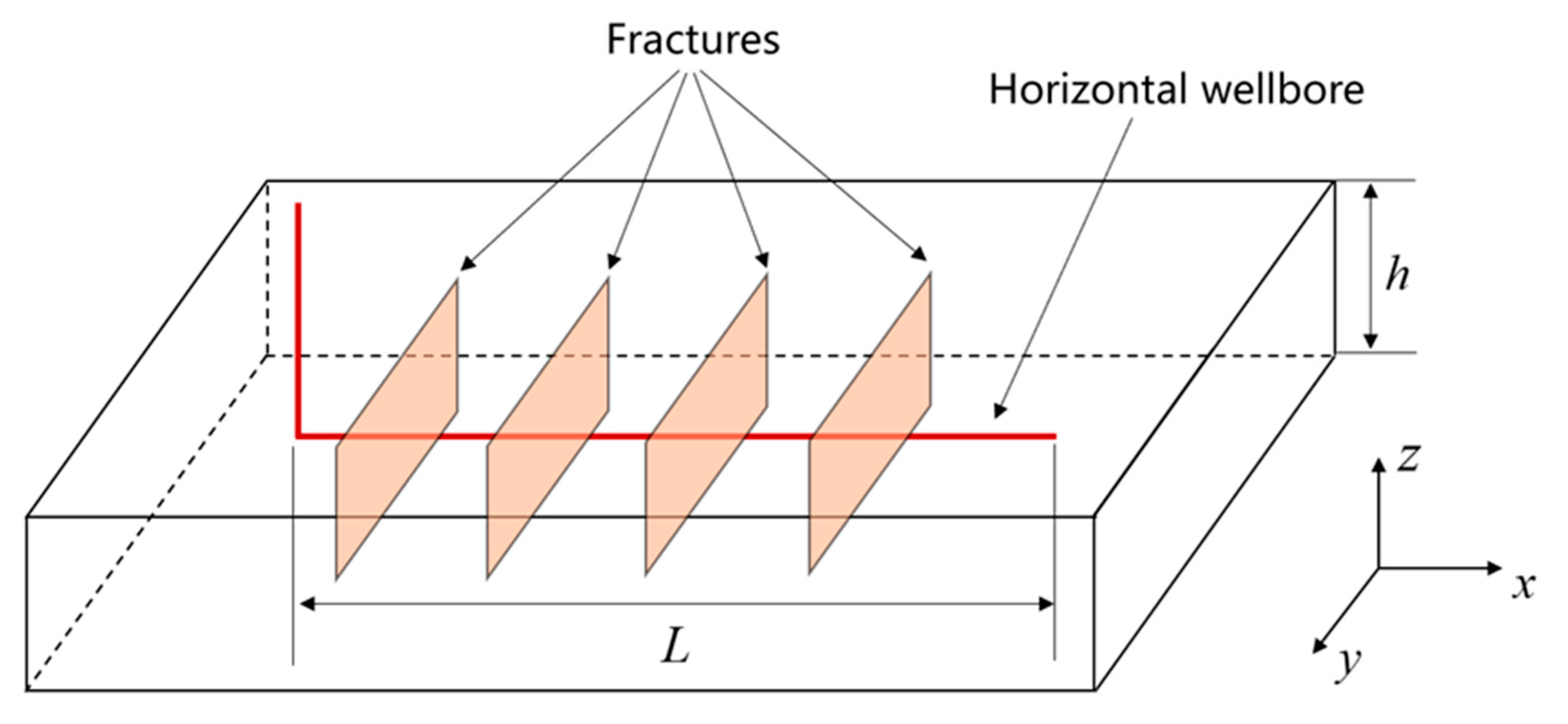



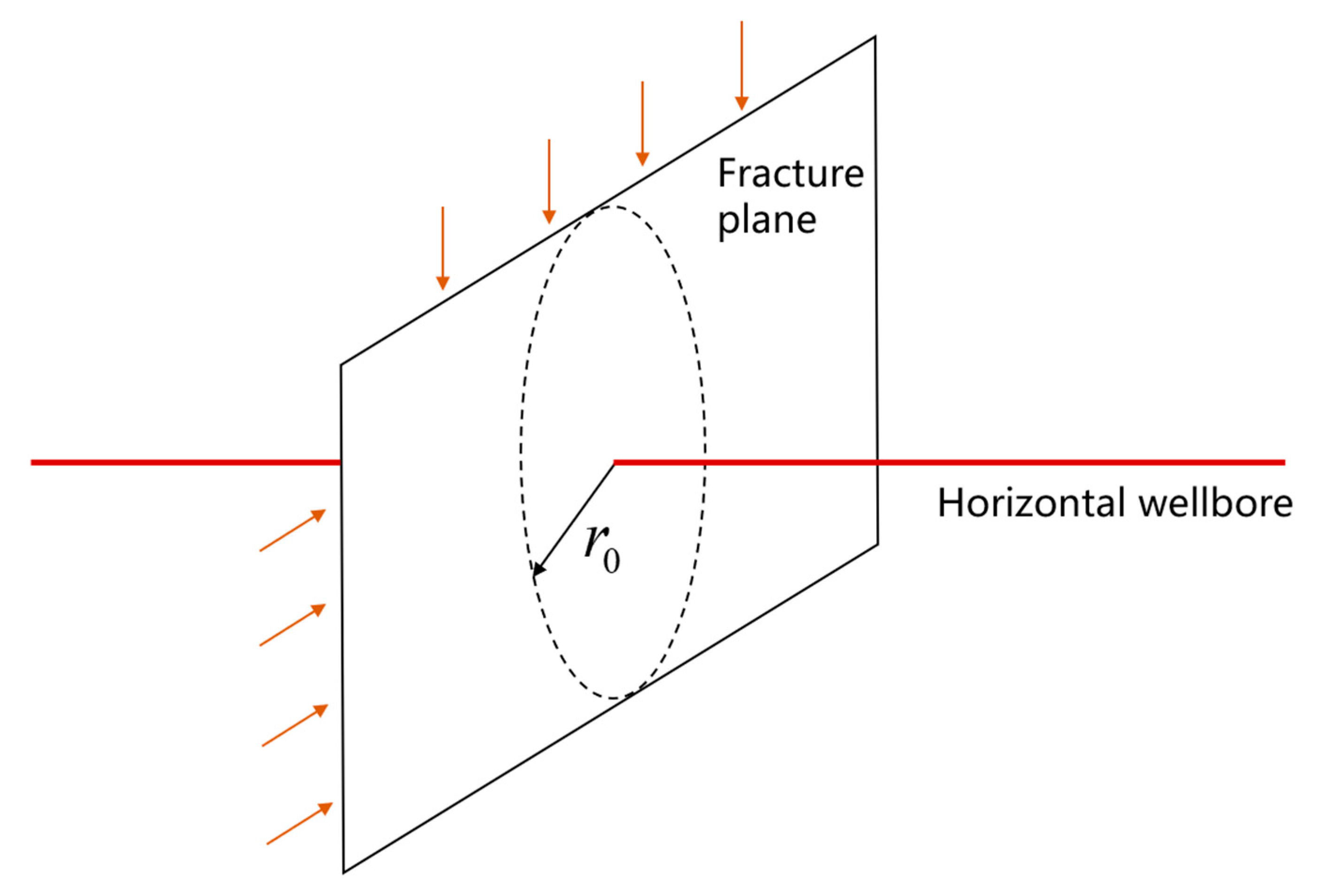
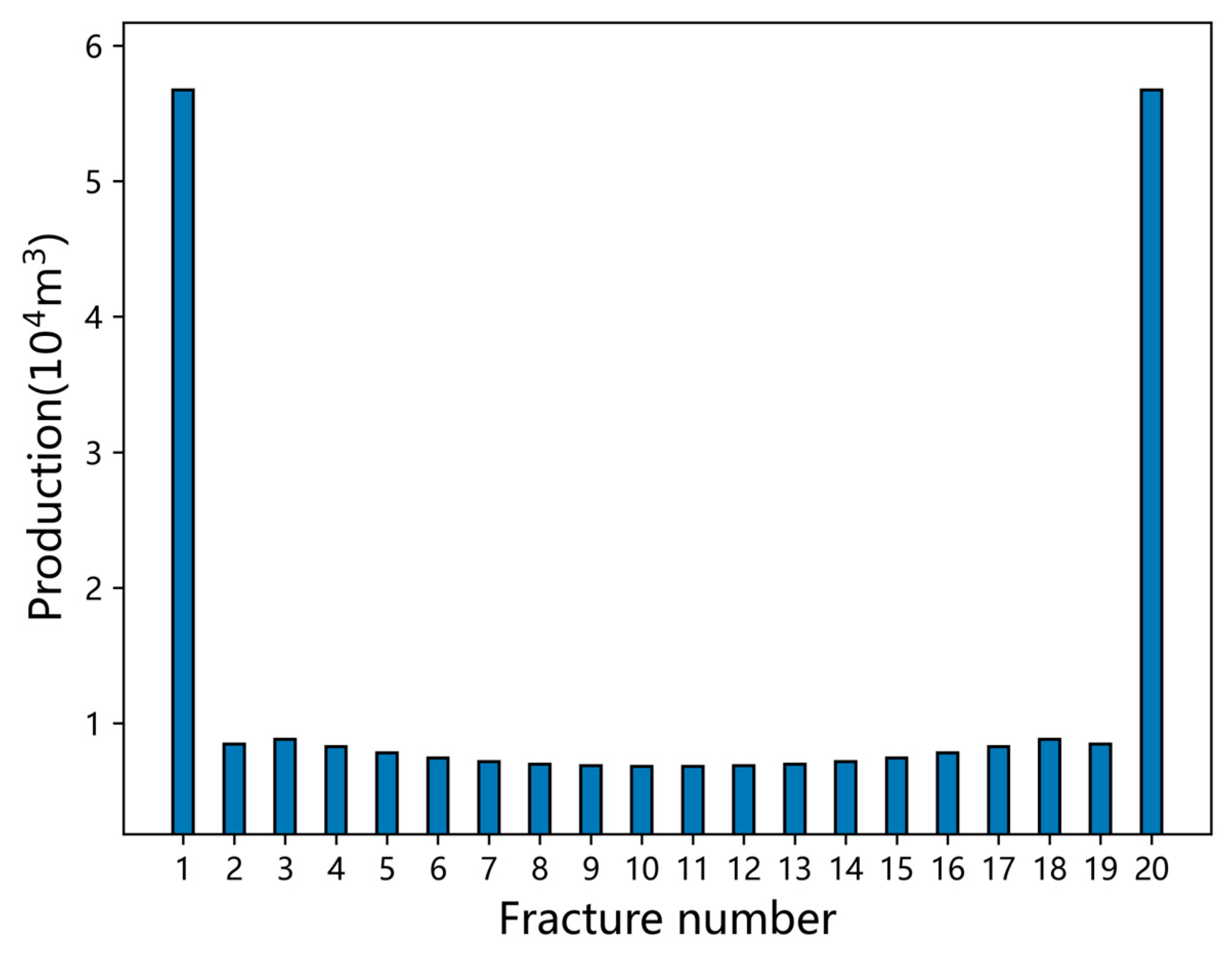
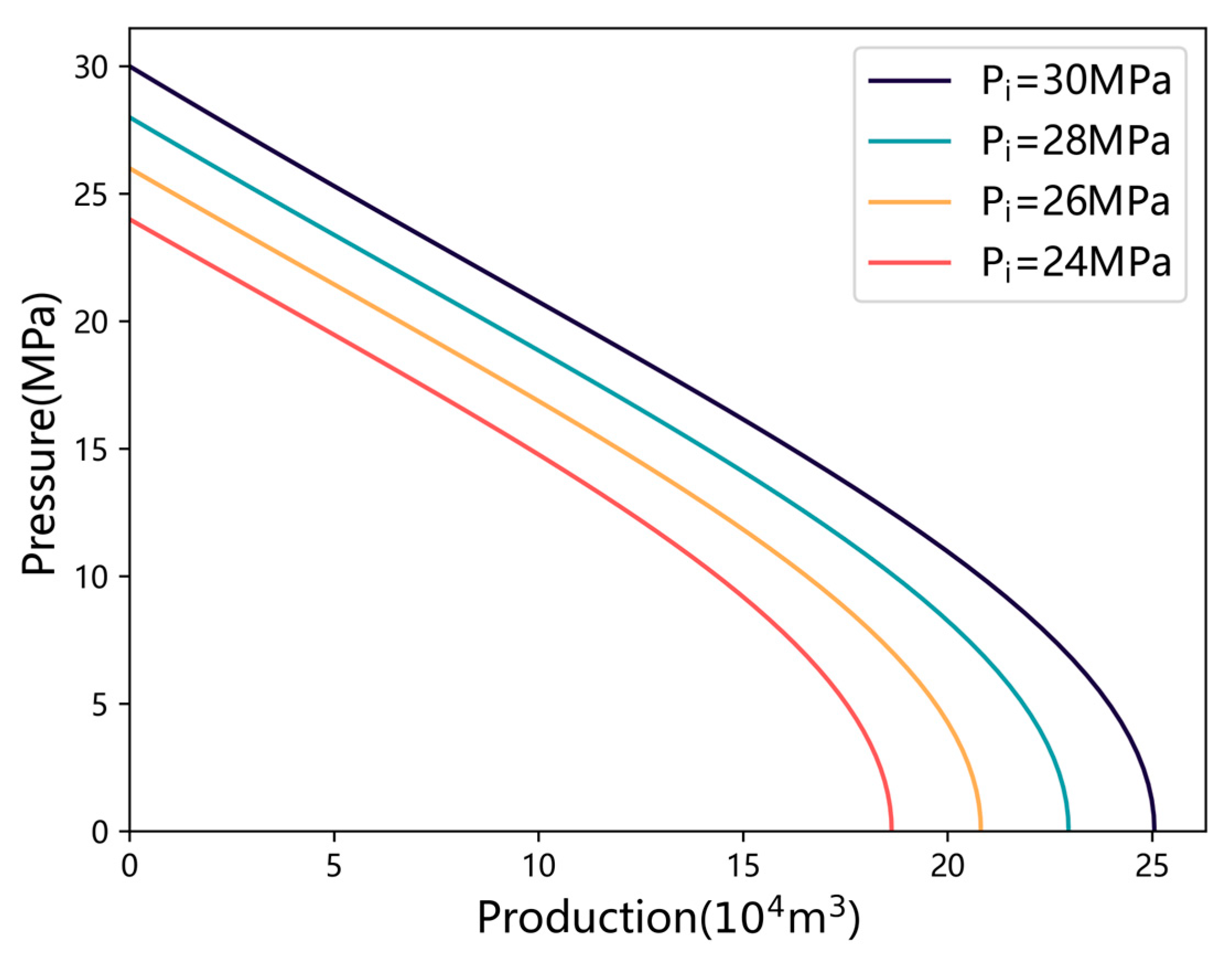
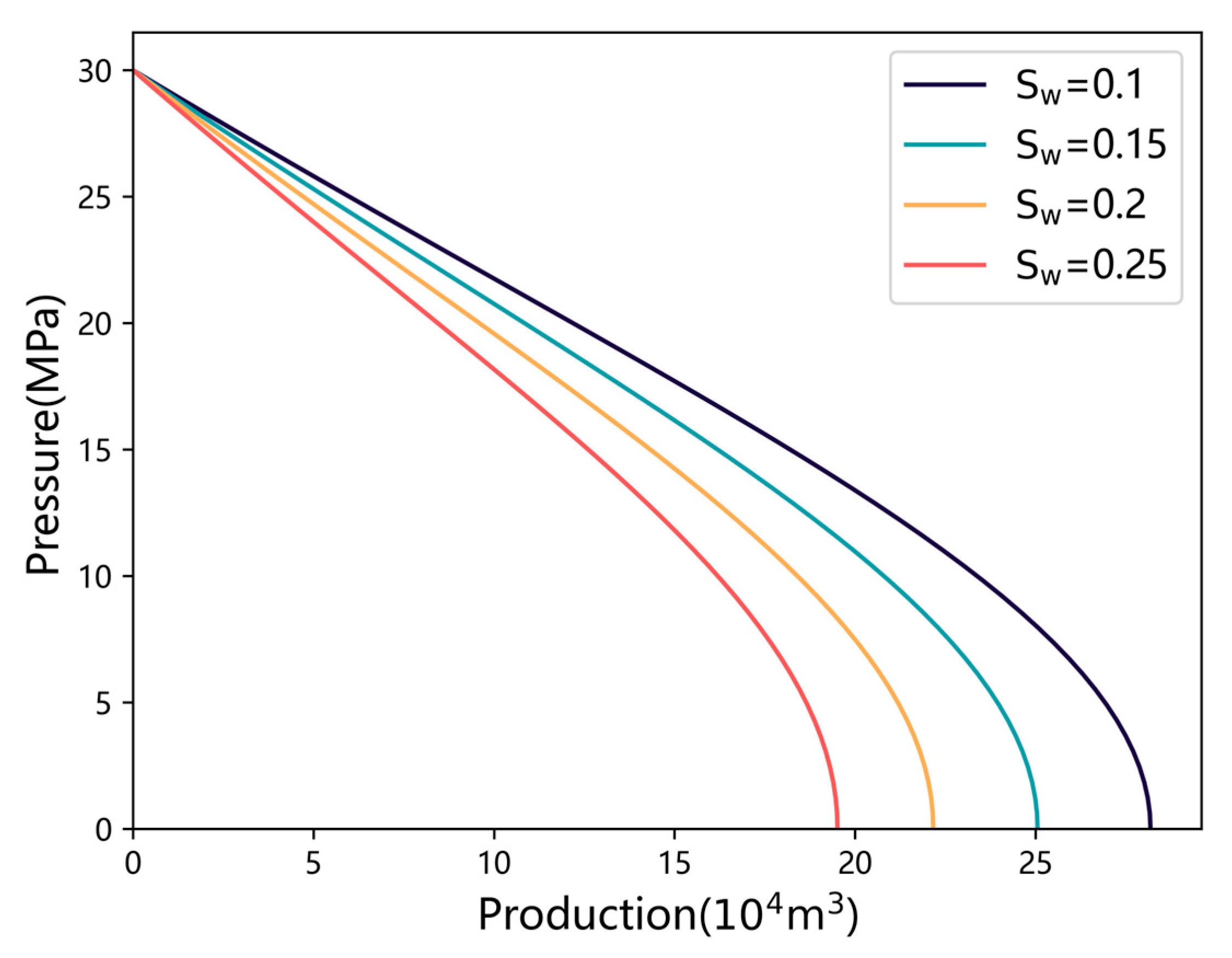
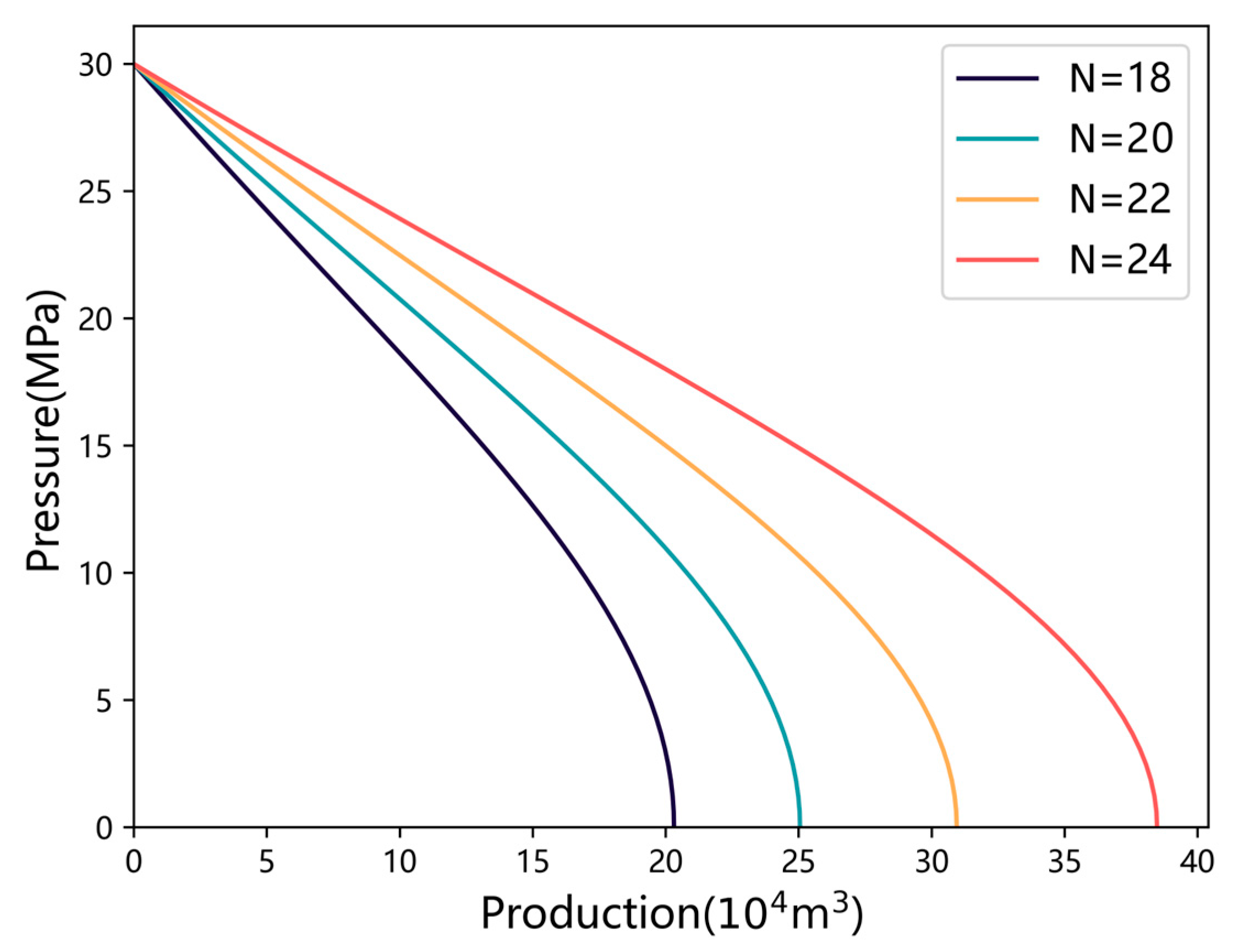
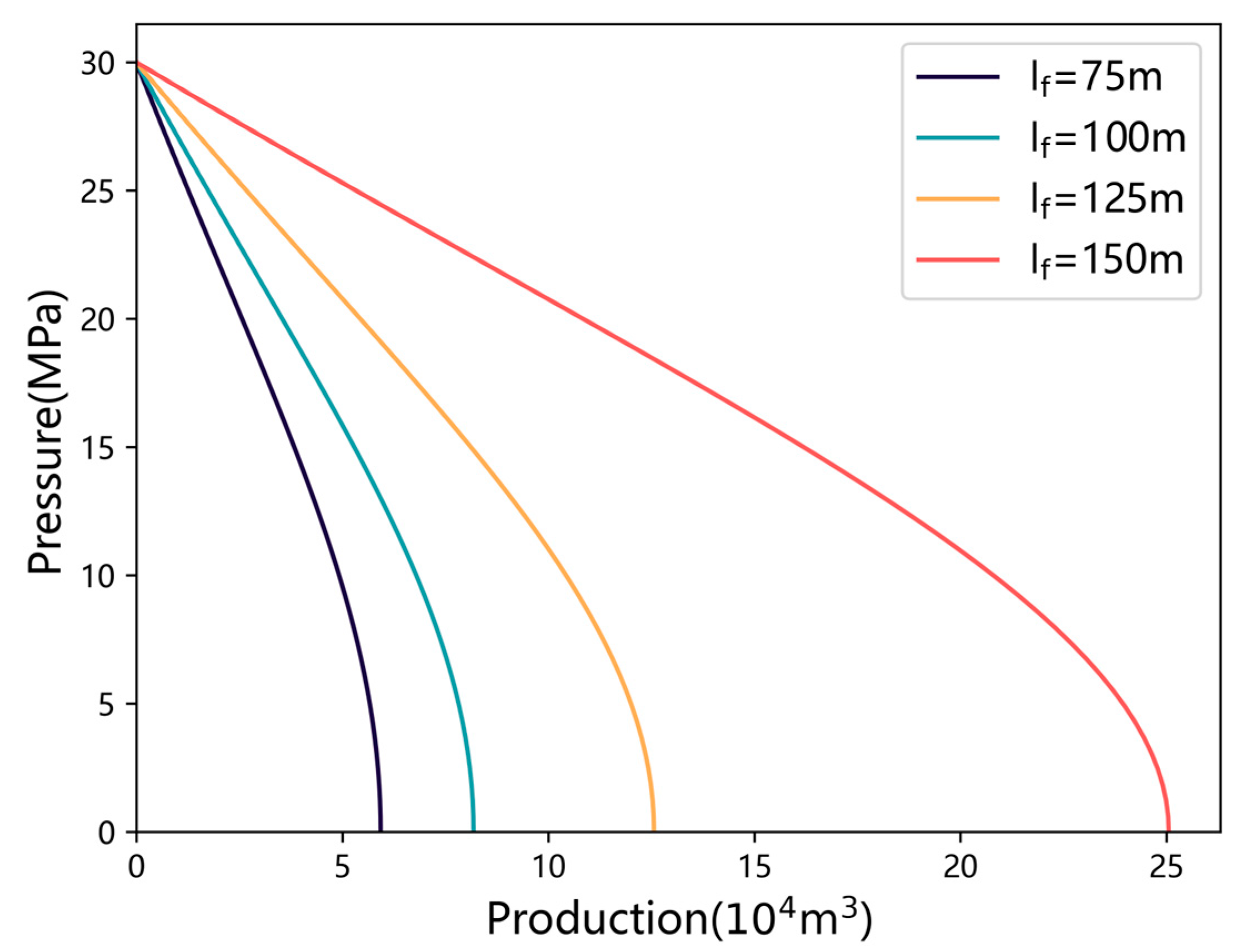
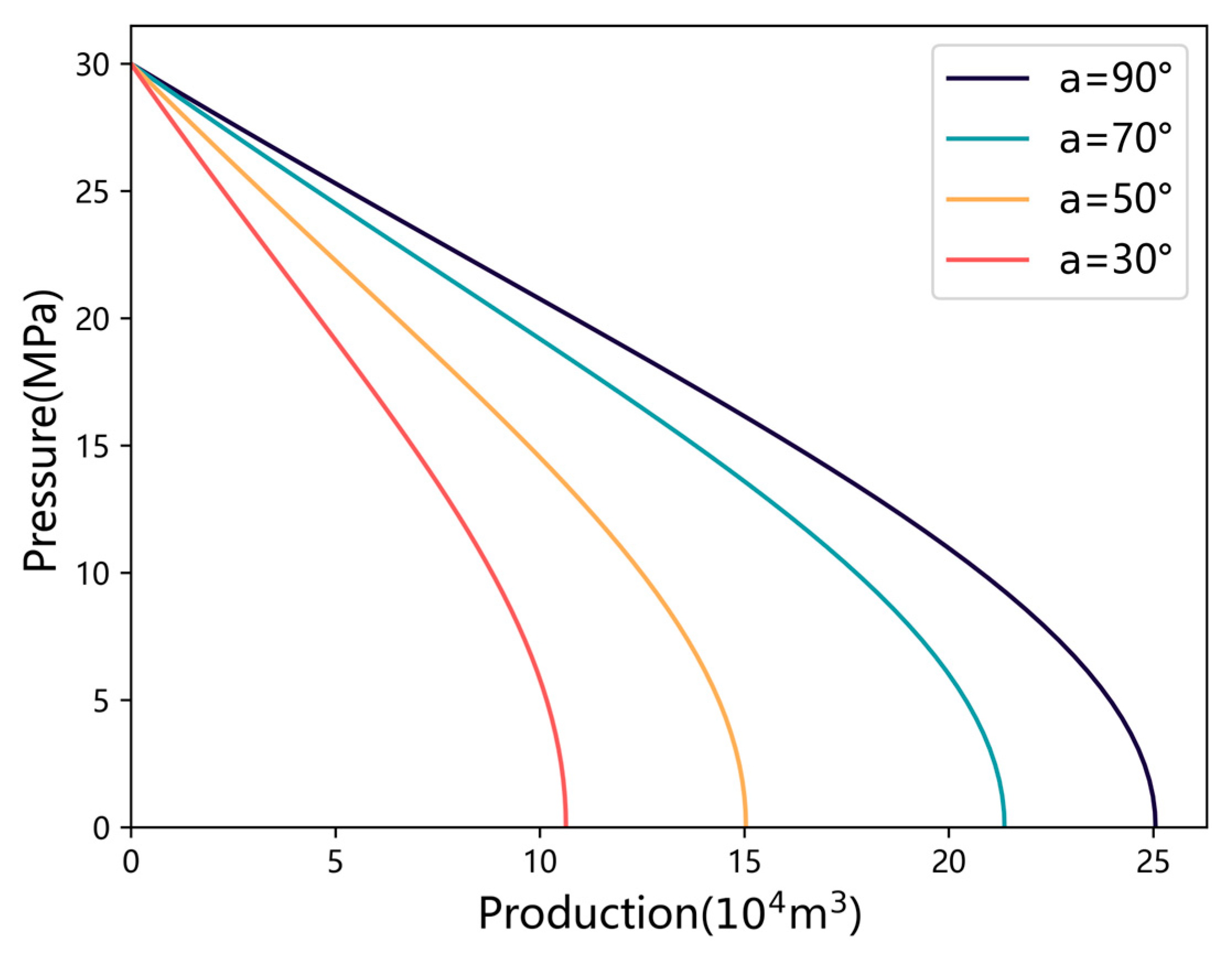

Disclaimer/Publisher’s Note: The statements, opinions and data contained in all publications are solely those of the individual author(s) and contributor(s) and not of MDPI and/or the editor(s). MDPI and/or the editor(s) disclaim responsibility for any injury to people or property resulting from any ideas, methods, instructions or products referred to in the content. |
© 2025 by the authors. Licensee MDPI, Basel, Switzerland. This article is an open access article distributed under the terms and conditions of the Creative Commons Attribution (CC BY) license (https://creativecommons.org/licenses/by/4.0/).
Share and Cite
Xiao, H.; He, S.; Chen, M.; Liu, C.; Zhang, Q.; Zhang, R. Two-Phase Production Performance of Multistage Fractured Horizontal Wells in Shale Gas Reservoir. Processes 2025, 13, 563. https://doi.org/10.3390/pr13020563
Xiao H, He S, Chen M, Liu C, Zhang Q, Zhang R. Two-Phase Production Performance of Multistage Fractured Horizontal Wells in Shale Gas Reservoir. Processes. 2025; 13(2):563. https://doi.org/10.3390/pr13020563
Chicago/Turabian StyleXiao, Hongsha, Siliang He, Man Chen, Changdi Liu, Qianwen Zhang, and Ruihan Zhang. 2025. "Two-Phase Production Performance of Multistage Fractured Horizontal Wells in Shale Gas Reservoir" Processes 13, no. 2: 563. https://doi.org/10.3390/pr13020563
APA StyleXiao, H., He, S., Chen, M., Liu, C., Zhang, Q., & Zhang, R. (2025). Two-Phase Production Performance of Multistage Fractured Horizontal Wells in Shale Gas Reservoir. Processes, 13(2), 563. https://doi.org/10.3390/pr13020563




